Across the UAE, loving dog owners are facing a common challenge: an increasing number of our furry companions are struggling with excess weight. This isn't just a cosmetic issue; it significantly raises their risk for serious health problems like arthritis, heart disease, and diabetes – conditions that can impact their quality of life, especially in our unique climate. If you're concerned your pup might be overweight, you're not alone. This guide cuts through the noise, offering clear, veterinarian-supported strategies tailored to help your dog in the UAE shed those extra pounds safely and effectively. Discover how to assess your dog's condition, master portion control with readily available foods (including "Weight Management Dry Dog Food UAE" options), and implement safe exercise routines suitable for our environment. Let's embark on a journey to a healthier, happier, and more active life for your beloved dog.
How Do I Know If My Dog Is Overweight?
Start with a simple at-home check:
- Rib Test: Gently glide your fingers along their ribs. You should feel them without pressing hard, like the back of your hand.
- Profile View: The belly should clearly tuck upwards behind the rib cage, showing no sagging .
- Top View: A slight hourglass shape between the ribs and hips.
Still unsure? Ask your vet for a Body Condition Score (BCS), a 1–9 scale where 4–5 is ideal.
How Much Should I Feed My Dog to Help Them Lose Weight?
Portion control is critical. Follow these steps: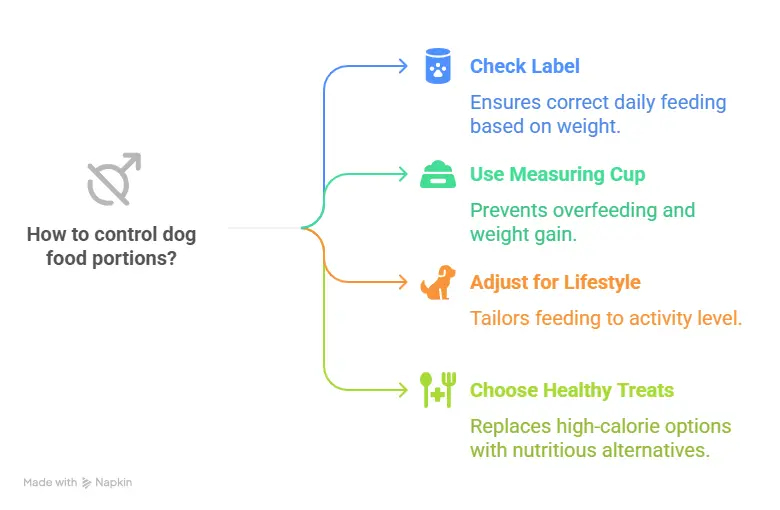
- Check the Label: Daily feeding guidelines on dog food packaging are typically determined by weight. As an example, a 30-pound dog could need 1.5 cups daily.
- Use a Measuring Cup: Never guess—overfeeding by just 10 extra kibbles daily can lead to a 1-pound gain per year.
- Adjust for Lifestyle:
- Active dogs (e.g., hiking companions): Add 10% more food.
- Couch pups: Subtract 10%.
- Treats Matter: Replace high-calorie biscuits with frozen blueberries, steamed carrots, or air-popped popcorn (no salt/butter).
Use Pro Nutrition Portion Calculator
Pro Tip: Feeding your dog 2–3 smaller portions throughout the day can help reduce begging. Additionally, slow feeders or puzzle toys can make mealtimes
What’s the Best Dog Food for Weight Loss?
Go to : Weight Management Dry Dog Food UAE
Look for these on the label: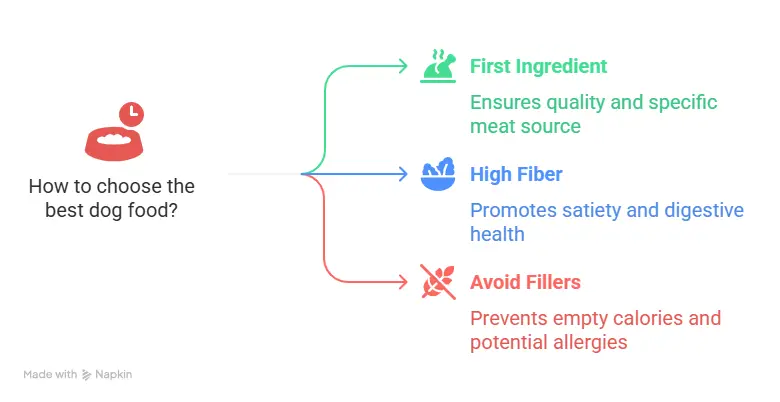
- First Ingredient: Named meat (e.g., “chicken,” “salmon”)—not vague terms like “meat meal.”
- High Fiber: Ingredients like pumpkin, sweet potato, or oats keep dogs full longer.
- Avoid Fillers: Corn, soy, and wheat gluten add empty calories.
Wet vs. Dry Food:
-
Wet food, being roughly 70% water, supports hydration and fullness. Mixing ¼ can with kibble creates a satisfying meal.
- Dry kibble is better for dental health but less filling.
Sample Meal Plan (30-pound dog):
-
For breakfast, offer ½ cup of high-protein kibble mixed with 1 tablespoon of plain pumpkin purée
- Dinner: ½ cup kibble + 2 oz cooked chicken breast (no skin)
- Treats: 3–4 baby carrots or green beans
Use Pro Nutrition Dog Food Finder to Get the perfect match for your Dog
How Can I Help My Dog Exercise Safely?
Plan for 30–60 minutes of daily activity for your dog, keeping their breed and age in mind when selecting exercises.
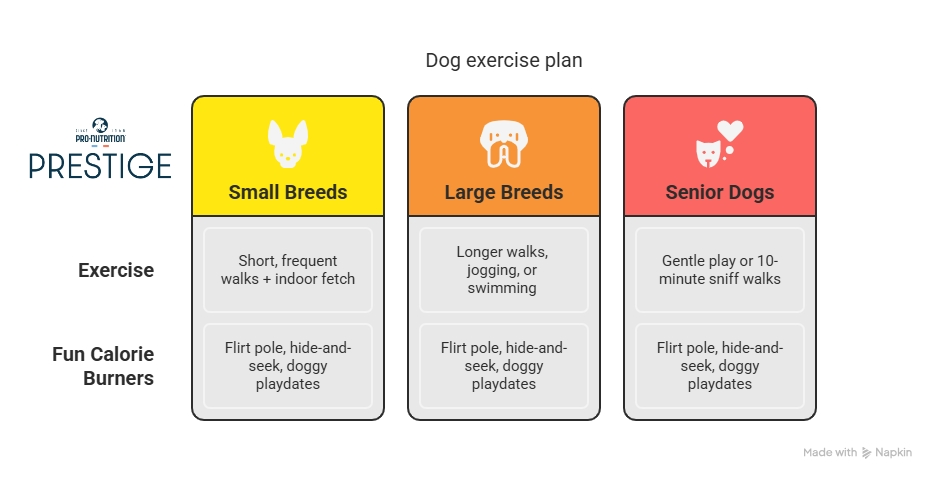
- Small Breeds: Short, frequent walks + indoor fetch.
- Large Breeds: Longer walks, jogging, or swimming (easy on joints).
- Senior Dogs: Gentle play or 10-minute sniff walks.
Fun Calorie Burners:
- Flirt pole (a stick with a toy on a rope) for high-energy dogs.
- Hide-and-seek with treats to engage their brain.
- Doggy playdates for social pups.
Tracking Progress: What Really Works
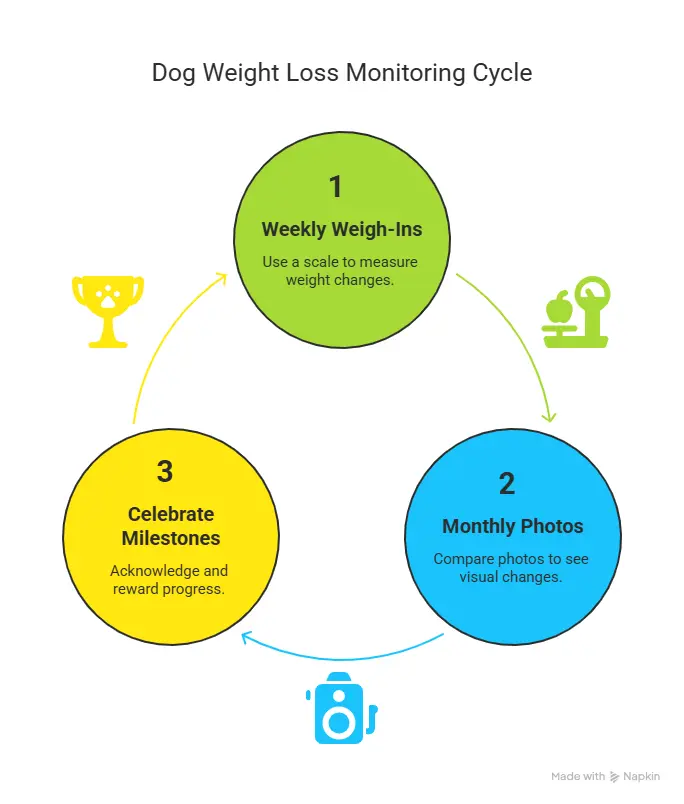
- Weekly Weigh-Ins: Use a bathroom scale. Hold your dog, subtract your weight, and track changes.
- Monthly Photos: Compare side/top views to spot subtle changes.
- Celebrate Milestones: A 5% weight loss (e.g., 2 lbs for a 40-lb dog) reduces diabetes risk by 30%.
Common Mistakes to Avoid
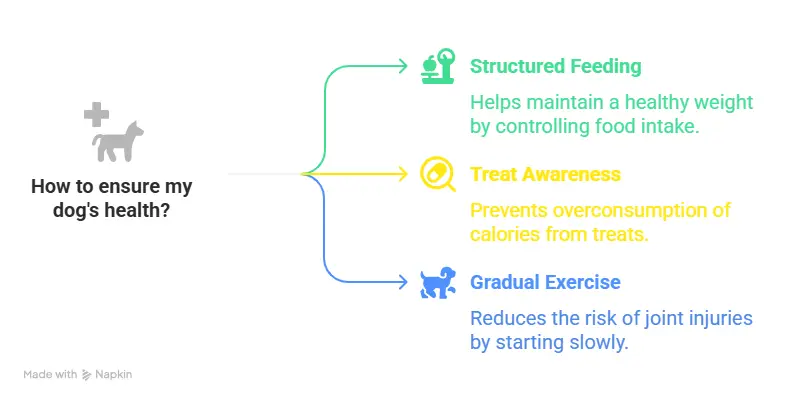
- Free Feeding: To help your dog maintain a healthy weight, avoid free feeding and adhere to a structured meal schedule.
- Ignoring Treat Calories: A single milk bone can be 10% of a small dog’s daily intake!
- Over-Exercising: Sudden intense activity can injure joints. Start slow.
When to Call the Vet
Consult a professional if:
- Your dog isn’t losing weight after 8–12 weeks.
- They show sudden weight gain, excessive thirst, or lethargy (signs of thyroid issues).
- You need a personalized plan—many vets offer free nutrition guides.
FAQ Section
Can I just feed my dog less of their current food?
A: Not always. Low-quality foods lack nutrients, so cutting portions may cause deficiencies. Switch to a vet-recommended weight-management brand.
Are grain-free diets better for weight loss?
A: Grain-free diets are now linked to potential heart problems in dogs. It's better to focus on foods rich in protein and fiber instead.
How long should dog weight loss take?
A: Aim for 1–2% of body weight per month. Rapid loss can harm organs.
Final Thoughts
Helping your dog lose weight isn’t about perfection it’s about progress. Small tweaks, like measuring meals and adding 10-minute play sessions, add up. Remember, you’re not just extending their life; you’re improving their zoomies, cuddles, and joy.
Your next step: Grab a measuring cup, check your dog’s food label, and schedule a vet checkup. You’ve got this!